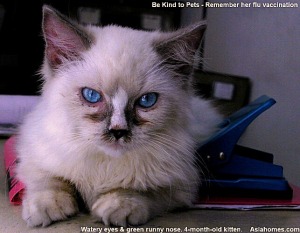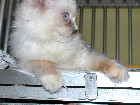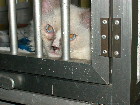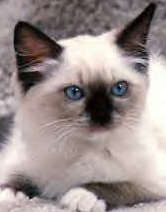INTERNET
COMMUNITY EDUCATION
"Be
Kind to Pets" - Tips for a longer life for pets. A Community
Education supported by Asiahomes Internet.
Article written in June 21, 2002.
The 24-hour guarantee expired
for the sneezing Ragdoll.
The four-month-old kitten was sold with a 24-hour return guarantee that
the money would be refunded if the cattery's veterinarian certified that it was suffering
from a bacterial or viral infection within 24 hours of purchase. It was sold with
the information that the kitten had been on two types of medication - one being an
antibiotic and one to stop runny nose for the last eight days.
 Now it was four days after purchase and the guarantee would not apply. The right
lower eyelid of this Ragdoll was redder than the left eye as it had conjunctivitis.
A thick and moist greenish black crescent of tears stained the side of nose on each side
below the eye. Now it was four days after purchase and the guarantee would not apply. The right
lower eyelid of this Ragdoll was redder than the left eye as it had conjunctivitis.
A thick and moist greenish black crescent of tears stained the side of nose on each side
below the eye.
"The kitten has a dark green discharge from its nose and is sneezing. It was not so
active the last two days. What's the problem?" the Owners asked me. I could see the
mucus oozing from the small nostrils and hear the faint sneezing. The
Ragdoll was
not well but it was not terribly sick at the time of examination.
"The Ragdoll has an upper respiratory tract infection," I said. "There is a
bacterial and possibly a viral infection of the nose and throat. The kitten objected to
any thermometer being placed into its rectum to check whether it had a fever or not. It
was still strong to resist such nonsense from the veterinarian. I looked at the tongue. It
was redder than normal and this could be a sign of fever.
I auscultated the chest of this quiet blue-eyed kitten with my stethoscope. "The
lungs are normal presently, but the infection may go further into the lungs causing
pneumonia and death. Much depends on the kitten's immunity to infections."
What was the cause of this
upper respiratory tract infection? Singapore catteries sell kittens brought in
from various sources - local and imported ones. It would be difficult to prevent viral
infections. Feline herpes virus 1 and caliciviruses are the most
common ones causing runny noses and sneezing.
"Was the kitten vaccinated twice?" I asked the Owners. Usually the pet dealer
would provide a vaccination certificate during sale but there was none in this case. The
cat dealer was contacted by mobile phone but there was a voice mail.
Now, what should I do? An antibiotic injection was necessary. More oral medication
for the next few days? It would not be easy for many new kitten owners in
Singapore to medicate a kitten.
Ideally, the
kitten should be warded and given injections for the next three days but would the Owners
bear the separation? What if the viral infection, for which there was no effective
drug cause the kitten's health to deteriorate and kill the kitten? The veterinarian
would be blamed.
Signs of upper respiratory tract infection may recur although the
kitten may be vaccinated. It may be vaccinated when it had maternal
antibodies and therefore, the vaccination would not be effective.
At week 6, the first vaccination is usually given in reputable
catteries in Singapore. and most kittens would not have
maternal antibodies to make vaccination ineffective.
 |
 |
 |
Blocked nose with greenish
discharge and tear stains from sore eyes in a sick Ragdoll kitten when first seen by the
veterinarian.
|
Usually the viral cause is the rhinotracheitis and the
calicivirus infections complicated by bacterial infections
like chalmydosis. |
Ragdoll recovered after 7 days and went home to a happy
owner. |
| |
 |
 |
| |
Clear eyes and nose in another healthy Ragdoll |
Clear eyes and nose in another healthy Ragdoll |
VIRAL INFECTIONS OF CATS IN
SINGAPORE
The commonest complaint of viral infection is the runny eyes,
coughing and sneezing in kittens and cats. This upper
respiratory tract infection is usually not fatal and is caused by
the rhinotracheitis virus (also known as the feline herpes
virus 1). A vaccinated cat may not show signs of runny eyes
and sneezing. Calicivirus also cause upper respiratory
tract infection.
Panleukopenia, or feline distemper are viral infections which
can kill cats. Vaccination works well as there are few cases seen in
practice.
Feline corona virus is a common intestinal virus that may
cause no
clinical signs or may cause diarrhea in cats who are infected with
it. This is
considered to be a minor viral infection in most cases, but when
feline
corona virus mutates, it can become deadly. If the mutant virus can
invade the rest of the cat's body it is referred to as feline
infectious
peritonitis (FIP), which is almost always a fatal infection.
There is a
vaccination for this virus but there are some questions about how
well
it works and most veterinarians do not use the vaccine on a routine
basis.
Feline immunodeficiency virus (FIV)
and feline leukemia virus (FeLV) are
retroviruses. These are viruses that attack the immune system and
weaken
it. This can lead to severe infections or even cancer in cats
infected
with these viruses. There is no vaccine for FIV at this time. There
is a
vaccine for FeLV. It is not as effective as vaccines against other
types of
viruses are but it works well enough that most veterinarians
recommend it for
cats who may be exposed to an infected cat. This would include
outdoor cats,
cats who live indoors and outdoors and even indoor cats who are
routinely exposed to a cat who goes in and out. Cats are most
susceptible to
feline leukemia virus when they are young and develop a natural
immunity as
they get older.
Feline leukemia virus was discovered
in 1964 and a test to detect it
that could be used in veterinarian's offices was developed in 1973.
A vaccine
was not approved until 1985, so it took almost twenty years for a
vaccine to reach the market that would help prevent this disease.
Over the last five or six years it
has become apparent that some cats
vaccinated against feline leukemia virus developed cancers where the
vaccines were given. The cancer is usually fatal if untreated
somewhere
between 50 and 70% of cats in which the cancer is treated will die
from
it. The rate of development of this cancer is thought to be between
1 in
2500 and 1 in 10,000 cats who are vaccinated against FeLV. Due to
this
problem, veterinarians are trying much harder to figure out if a cat
is at risk
for getting feline leukemia virus before giving the vaccine. In
young cats,
it is usually better to give the vaccine if there is any suspected
risk. In
older cats (over 2 years of age) it is probably better not to give
the
vaccine unless there is a definite risk of exposure to an infected
cat.
|
 INTERNET
ADS
INTERNET
ADS